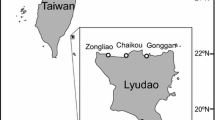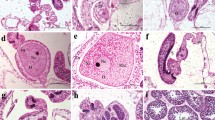Abstract
Many scleractinian corals only spawn once a year, so opportunities for collecting their gametes are limited. Consequently, the induction of spawning in coral would be useful, not only for studies on the mechanisms of coral reproduction, but also for stock enhancement. A spawning-induction method using hydrogen peroxide (H2O2) has already been developed for coral, but most adult corals died after exposure to H2O2. In the present study, a comparison of the effects of low concentrations of H2O2 (0.5–1.5 mM) on adult corals indicated that 1 mM H2O2 was the upper threshold for inducing spawning without harmful effects. In addition, the effect of repeated exposure to H2O2 on the same colony, and the relationship between the timing of H2O2 exposure and the lunar phase, were investigated. The success rate of induced spawning was dependent not on H2O2 concentration but largely on the time lag between exposure to H2O2 and timing of natural mass spawning. Spawning was induced in ≥ 70% of coral colonies when they were exposed to H2O2 within the 2-day period prior to a natural mass spawning event. The described technique is not only useful for the collection of artificially induced coral gametes, but also for estimating the specific timing of natural mass spawning of coral.




Similar content being viewed by others
References
Baird AH, Guest JR, Willis BL (2009) Systematic and biogeographical patterns in the reproductive biology of scleractinian corals. Annu Rev Ecol Evol Syst 40:551–571
Brostrom G (2019) glmmML: generalized linear models with clustering. R package version 1.1.0.
dela Cruz DW, Harrison PL (2017) Enhanced larval supply and recruitment can replenish reef corals on degraded reefs. Sci Rep 7:13985
Drori S, Ofir M, Levavi-Sivan B, Yaron Z (1994) Spawning induction in common carp (Cyprinus carpio) using pituitary extract or GnRH superactive analogue combined with metoclopramide: analysis of hormone profile, progress of oocyte maturation and dependence on temperature. Aquaculture 119:393–407
Fogarty ND, Marhaver KL (2019) Coral spawning, unsynchronized. Science 365:987–988
Fujiwara A, Yamano K, Ohno K, Yoshikuni M (2010) Spawning induced by cubifrin in the Japanese common sea cucumber Apostichopus japonicus. Fish Sci 76:795–801
Gibbonsa MC, Castagna M (1984) Serotonin as an inducer of spawning in six bivalve species. Aquaculture 40:189–191
Hayashibara T, Iwao K, Omori M (2004) Induction and control of spawning in Okinawan staghorn corals. Coral Reefs 23:406–409
Heyward AJ, Smith LD, Rees M, Field SN (2002) Enhancement of coral recruitment by in situ mass culture of coral larvae. Mar Ecol Prog Ser 230:113–118
Keith SA, Maynard JA, Edwards AJ, Guest JR, Bauman AG, van Hooidonk R, Heron SF, Berumen ML, Bouwmeester J, Piromvaragorn S, Rahbek C, Baird AH (2016) Coral mass spawning predicted by rapid seasonal rise in ocean temperature. Proc R Soc B 283:20160011
Kikuchi S, Uki N (1974) Technical study on artificial spawning of abalone, genus Haliotis. II. Effect of irradiated sea water with ultraviolet rays on inducing to spawn. Bull Tohoku Reg Fish Res Lab 33:79–86
Loosanoff VL, Davis HC (1963) Rearing of bivalve mollusks. In: Russell FS (ed) Advances in marine biology, vol 1. Academic Press, London, pp 110–112
Loya Y, Sakai K, Yamazato K, Nakano Y, Sambali H, van Woesik R (2001) Coral bleaching: the winners and the losers. Ecol Lett 4:122–131
Marshall PA, Baird AH (2000) Bleaching of corals on the Great Barrier Reef: differential susceptibilities among taxa. Coral Reefs 19:155–163
Moss GA, Illingworth J, Tong LJ (1995) Comparing two simple methods to induce spawning in the New Zealand abalone (paua), Haliotis iris. N Z J Mar Freshwater Res 29:329–333
Pratchett MS, Schenka TJ, Baine M, Syms C, Baird AH (2009) Selective coral mortality associated with outbreaks of Acanthaster planci L. in Bootless Bay Papua New Guinea. Marine Environ Res 67:230–236
Ross C, Fogarty ND, Ritson-Williams R, Paul VJ (2017) Interspecific variation in coral settlement and fertilization success in response to hydrogen peroxide exposure. Biol Bull 233:206–218
Suzuki G, Arakaki S, Suzuki K, Iehisa Y, Hayashibara T (2012) What is the optimal density of larval seeding in Acropora corals? Fish Sci 78:801–808
Suzuki G, Yamashita H, Kai S, Hayashibara Takeshi T, Suzuki K, Iehisa Y, Okada W, Ando W, Komori T (2013) Early uptake of specific symbionts enhances the post-settlement survival of Acropora corals. Mar Ecol Prog Ser 494:149–158
van Woesik R (2009) Calm before the spawn: global coral spawning patterns are explained by regional wind fields. Proc R Soc B 277:715–722
Zayasu Y, Suzuki G (2019) Comparisons of population density and genetic diversity in artificial and wild populations of an arborescent coral, Acropora yongei: implications for the efficacy of “artificial spawning hotspots”. Restor Ecol 27:440–446
Acknowledgements
This study was funded by the Japan Society for the Promotion of Science (Grant 15H04538 to G. S.). The author thanks H. Yamashita, Y. Fujikura, and C. Shinzato for their assistance with experiments. The sampling of corals was permitted by the Okinawa Prefectural Government for research purposes (permit nos. 25-49, 26-68, 27-73, 28-76, 29-74, 31-1).
Author information
Authors and Affiliations
Corresponding author
Additional information
Publisher's Note
Springer Nature remains neutral with regard to jurisdictional claims in published maps and institutional affiliations.
Electronic supplementary material
Below is the link to the electronic supplementary material.
Rights and permissions
About this article
Cite this article
Suzuki, G. Optimization of a spawning‑induction protocol for the prediction of natural coral spawning. Fish Sci 86, 665–671 (2020). https://doi.org/10.1007/s12562-020-01425-1
Received:
Accepted:
Published:
Issue Date:
DOI: https://doi.org/10.1007/s12562-020-01425-1




